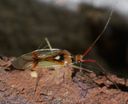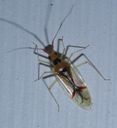Hyaliodes
Hyaliodes
Classification
- Phylum: Arthropoda
- Subphylum: Hexapoda
- Class: Insecta
- Order: Hemiptera
- Suborder: Heteroptera
- Infraorder: Cimicomorpha
- Superfamily: Miroidea
- Family: Miridae
- Subfamily: Deraeocorinae
- Tribe: Hyaliodini
- Genus: Hyaliodes
Pronunciation
How to pronounce Hyaliodes: /haɪ.əˈlaɪ.əˌdiz/
These audio files are automatically generated. While they are not always 100% accurate, they are a good starting point.
Images






Summary
Hyaliodes is a genus of plant bugs known for its distinctive transparent hemelytra, with at least 20 described species, primarily found in the New World, particularly in neotropical regions.
Physical Characteristics
4-5 mm in size, distinctive transparent hemelytra.
Identification Tips
Look for the transparent hemelytra and small size (4-5 mm).
Habitat
Eastern shrubs and trees in woodlands, parks, and orchards in North America.
Distribution
New World, ranging from Canada to Chile, predominantly neotropical.
Diet
Larvae and adults feed on leaf-eating mites; adults also suck sap from leaves.
Life Cycle
One generation per year; overwinters as an egg.
Reproduction
Reproduces once yearly, with eggs overwintering.
Ecosystem Role
As a sap-sucking insect, it plays a role in the ecosystem by interacting with plant health and mite populations.
Evolution
A member of the tribe Hyaliodini, which contains a total of 25 genera.
Tags
- plant bugs
- Hemiptera
- Miridae
- Hyaliodes